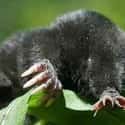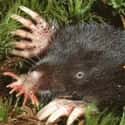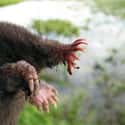-
(#6) They Devour Their Prey Outrageously Fast
It takes approximately 227 milliseconds for a star-nosed mole to identify and eat its prey. If that sounds fast, that's because it is. This mole is the fastest-eating animal in the world. Thanks to its teeth - which act as tweezers plucking small morsels out of the dirt for sustenance - the mole can get a meal and get it fast.
Also, the 22 tentacles on its face help locate food as the mole digs through the darkness. Scientists report that sometimes this star-shaped nose outpaces the mole's brain, causing the mole to skip over food until its nervous system can catch up and process what just happened.
-
(#4) Their Tentacles Act As Eyes
Star-nosed moles' incredibly poor eyesight makes sense because they live underground, so there is little light in their habitat. Scientists believe the moles' sensory rays evolved in response, with one master ray doing most of the sensing to bring items to the other rays' attention. The tentacles' movement is similar to the fast, nearly imperceptible eye movements of other mammals, and it comparably triggers brain activity as eyesight does in other creatures. The tentacles focus on one small thing, much like the eyes, while the rest of the sensory organs act in support of the primary sensing organ.
-
(#1) Their Nose Tentacles - Or Rays - Are Extremely Sensitive
The star on the star-nosed mole's face consists of 22 tentacles the mole uses to sense the world around it. As it moves through the underground darkness, the mole utilizes the 100,000 sensory neurons embedded in its tentacles to detect food. Scientists call the tentacles "rays," and each set of 11 tentacles has a master ray to which the others react. When the master ray finds a potential source of food, the other rays begin feeling it out, too and quickly identify it so the mole can decide the proper course of action.
According to Natural History magazine, "Under a microscope, the... organs appear in a honeycombed pattern of tiny epidermal 'domes,' each sensitive to the slightest touch."
-
(#9) They Love Slimy Things
This strange-looking creature has an appetite for the things that typically seem gross to the human population, including earthworms, beetle larvae, and other invertebrates. Star-nosed moles living near water add crustaceans, mollusks, and amphibians - sometimes even dragonflies and damselflies as well - to their diets.
-
(#10) They Are Partially Aquatic And Love To Burrow
The star-nosed mole inhabits territory ranging from the Eastern Seaboard to the Upper Midwest of the US and Canada. They typically make their homes near bodies of water and are semiaquatic, preferring to live near streams, rivers, lakes, and swamps.
Star-nosed moles like to live underground, but enjoy both cold and warm climates; these talpids construct tunnels where they live - anywhere from just below ground level to 60 centimeters under the surface.
-
(#5) They Can Smell Underwater
The star-nosed mole is one of two animals that can smell underwater; the other is the water shrew. Air is necessary to detect smells, so while underwater, the moles blow tiny bubbles from their nose and rapidly inhale them again, drawing the odors of underwater objects into the range of their olfactory sensors.
In an experiment, scientists showed the moles could follow an underwater trail leading to food by smell. Said moles had an 85% success rate at finding dinner.
New Random Displays Display All By Ranking
About This Tool
The star-nosed mole is a small mole found in eastern North America, eastern Canada, and the northeastern United States. They live in humid environments and feed on small invertebrates, aquatic insects, earthworms, and mollusks. Like other species of moles, star-nosed moles dig tunnels not far from the ground to find food, and the exits of these tunnels are usually under the water.
Studies have found that the star-nosed mole is the fastest-moving mammalian predator in the world. If you are interested in this small animal, welcome to check this random tool which introduced 11 facts about star-nosed moles that most people do not know.
Our data comes from Ranker, If you want to participate in the ranking of items displayed on this page, please click here.
















